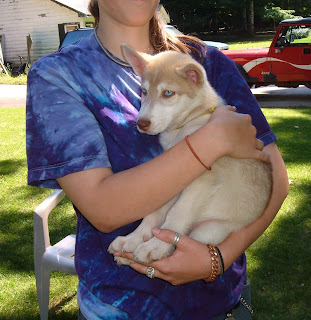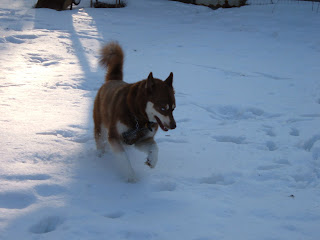I've read on other websites that huskies are good mousers, and have well-developed hunting instincts. Well, I believe it now, as scarcely a week goes by that one of our dogs does not have a new mouse, chipmunk, or squirrel trophy. Okay - you got me - sometimes a couple of weeks go by, but still, I had no idea we had so many little critters close to the house. A couple of pictures are included at the lower portion of this blog to substantiate this claim. I've chosen the lower area so you can avoid the pictures, if you wish. But there's nothing graphic - it's just that I know some people will think - aawww, the poor little critter.
Lobo, the red full husky, will sometimes completely ignore us humans when he's intent on searching for a small critter. Be wary of that if you're a husky owner - the convenient apparent deafness of your dog. Willy, the shepherd mix, will usually at least listen to us humans, and she definately knows what we mean by "find the mouse!" She gets very intense, and will search all of the surrounding area - especially anywhere we point or poke at with a stick.
Now, the normal hunting zone is, of course, the area each is cabled to by our house when the family is away. There are an abundance of sunflower seeds spilled into my flower garden area, and under the back deck, by the energetic goldfinches (our most abundant visitors). And, we have large beech trees in front that contribute beechnuts for birds, chipmunks, and mice. As the snow melted this spring, I could see where mice had created tunnels through the spilled seeds and shells to get under the deck. BTW, the flowers are fenced in, or I wouldn't have any after a doggie (on a cable) tromped, turned, dug, and laid in them. So some mice get away with months of local living before "their time is up" by sticking to the fenced area and moving when the dogs are inside.
The competition for catching any particular mouse, when both dogs are on the hunt with one of us at the same time, is entertaining to watch. Willy, as the alpha will frequently lead. Lobo, excitable, will follow, run circles, check nearby areas, jump (front feet) on Willy's back (making her mad - she'll grow and snap at him), and (sometimes) try to push his head in front of Willy's. At times, one or the other will give up too soon at a particular area, only to have the rival dog dig at just the right area and !Pounce! on the prize. Still, they each get their share.
Below is a series of three pictures showing Lobo scenting a mouse through a foot of snow, pouncing, and bringing the prize over for inspection. The strange alignment is due to the limitations of the Google's Blogger editing tools. The HTML tags with the photos are weird enough, I'm not messing with them too much.



Here's one that my siblings and family didn't want to see, as they felt bad for the squirrel. Willy

caught this black squirrel all by herself. Yes, the dogs will sometimes eat the squirrel (or other rodents), but not always.
Finally, here's a new one. Lobo caught a mole this April, and I have never even seen any mole trails. Yes, it's a snowy Easter week here, too, like most of the

eastern United States. So much for our very short spring, and enjoying the crocuses, daffodils, tulips, and forscythia bushes, though I know the warm weather will return.
One more thought. Does your dog like to roll on their catch? Ours do, especially if it's aged a bit. We take turns "losing" the several-day-old prizes in the deeper woods. Phew!

 socialization of the new pup with our current dogs; puppy teeth and chewing; and just plain fun and pictures.
socialization of the new pup with our current dogs; puppy teeth and chewing; and just plain fun and pictures.















